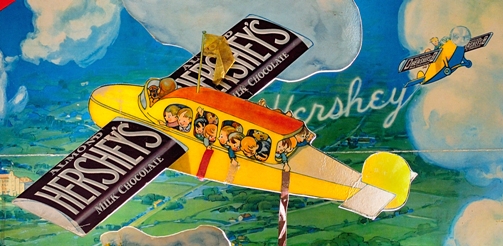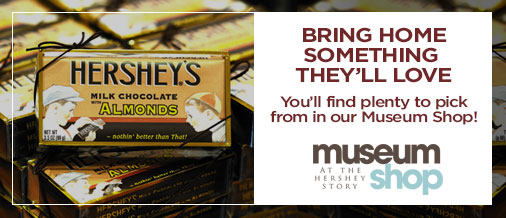by Valerie Seiber
In September 1970, The Hershey Company inaugurated its first national mass media advertising campaign with radio and television spots; fairly late in the game by advertising industry standards!

Because of this, many people believe that Mr. Hershey did not advertise. But this assumption is false. So how did the Hershey bar become such an iconic and recognized brand? Mr. Hershey promoted his product in numerous other ways. He brought the first automobile to Lancaster in 1901, a Riker electric car that advertised “Hershey’s Cocoa” on the side. Early newspaper advertisements encouraged housewives to write to the company for a free trial sample of Hershey’s Cocoa. Small promotional items were given away with the purchase of Hershey products. Postcards wrapped in milk chocolate bars were another surprise treat. The company even advertised on a billboard next to the Brooklyn Bridge in 1902!
Perhaps one of the more creative methods included elaborate store-front window displays that used a mix of beautiful original artwork and Hershey’s famous chocolate products. Store front displays were a popular advertising medium during the early 20th century. The Confectioner’s Journal published by The National Confectioners Association, (of which Mr. Hershey was a member) dedicated an entire section to window display techniques. These displays had to be eye-catching in order to stop potential customers passing by on the street. Few of these window display pieces exist today because of the disposable nature of the medium. Displays were often made of paper with explicit instructions to be discarded at the end of the promotional period.

One surviving example featured airplanes with Hershey’s Almond Milk Chocolate bar wings flying over the town and chocolate factory. The piece incorporated several “pop-up” elements to give it dimensionality, and yet folded flat for shipping. Smaller, separate companion pieces were also included as part of the display. Store owners could customize the look based on the size of the window. The instructions even recommend using a small fan to create motion:
“The display is good with or without motion – but advertising punch and sales value are increased by having the propeller and ribbons in motion.”
Sadly the propeller and most of the ribbons have not stood the test of time. Colorful and fun, the display is just as eye-catching now as it was 80 years ago. It remains one of my favorite pieces of early Hershey’s advertising art.


